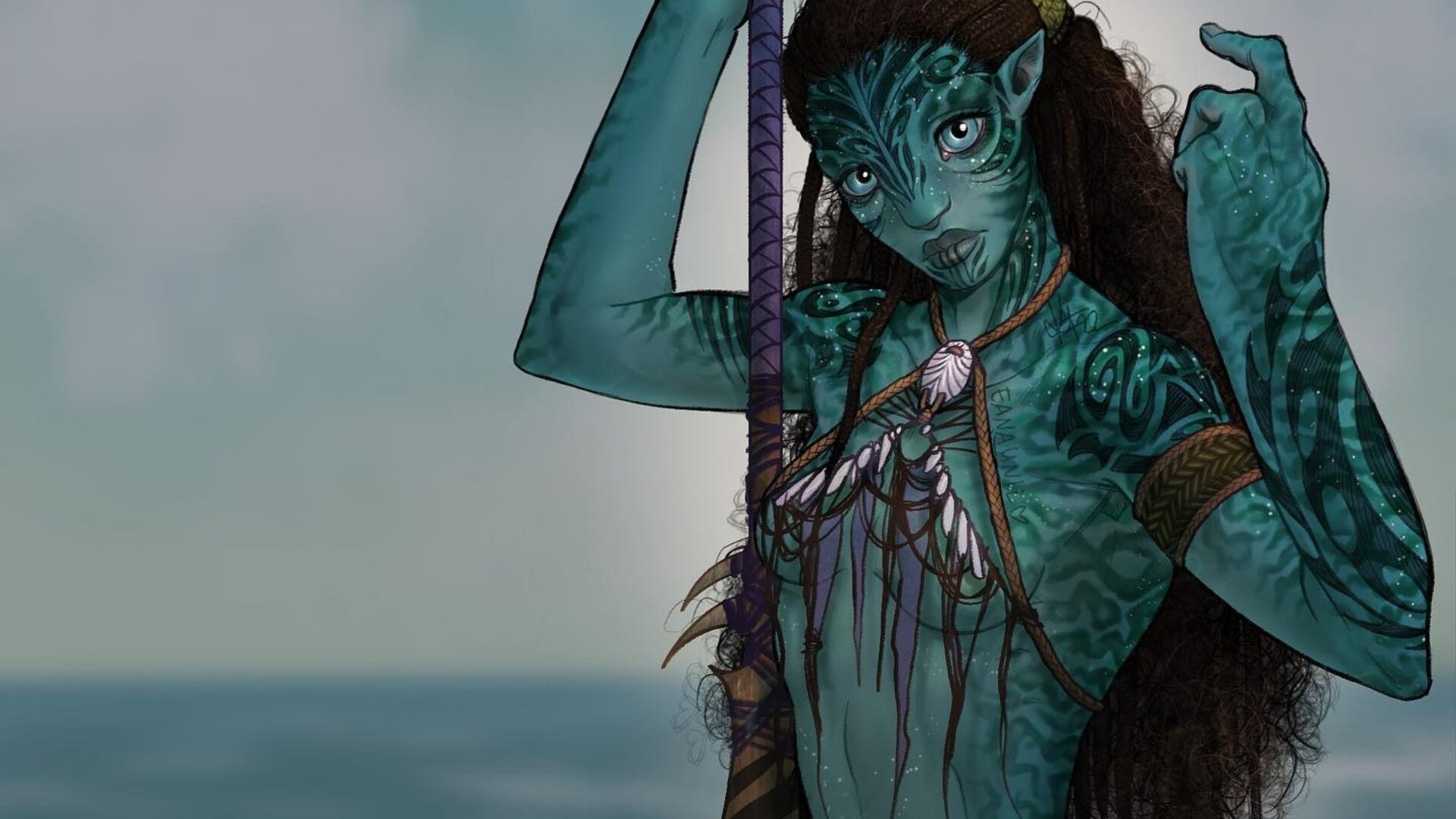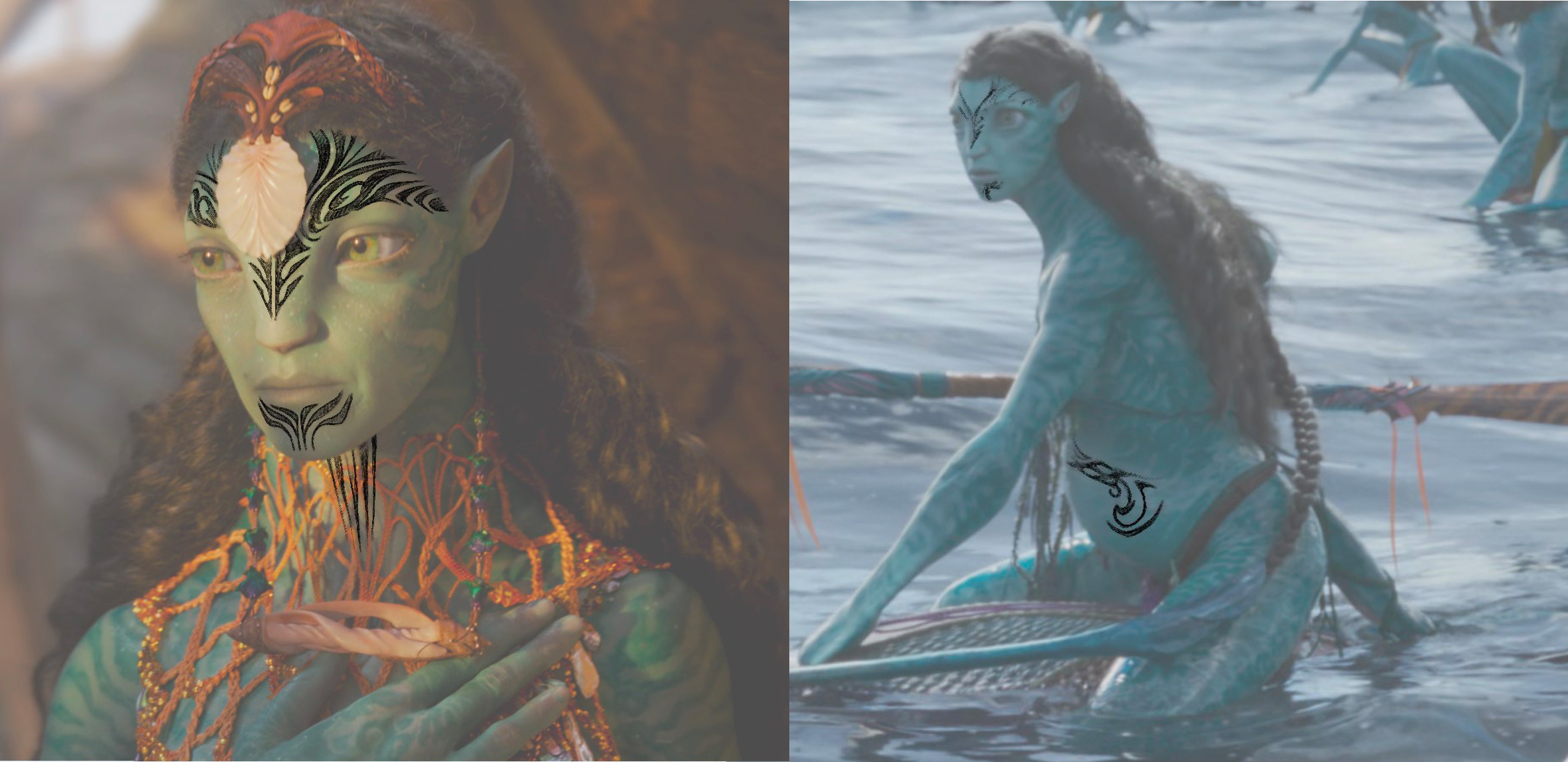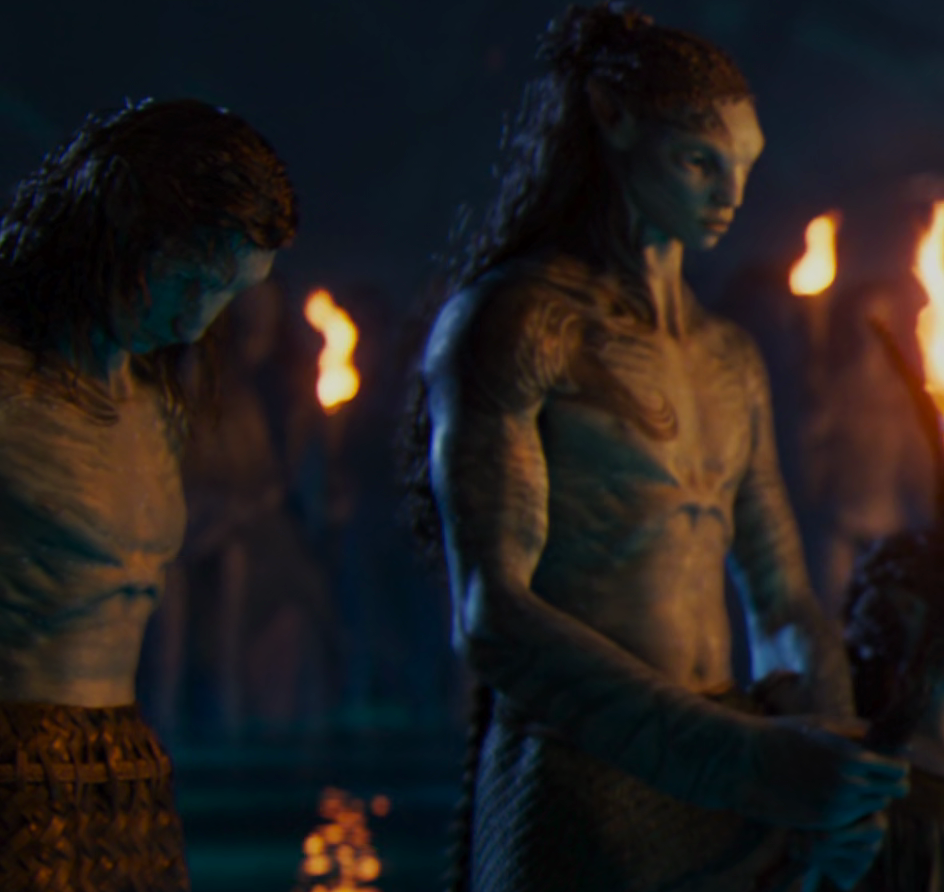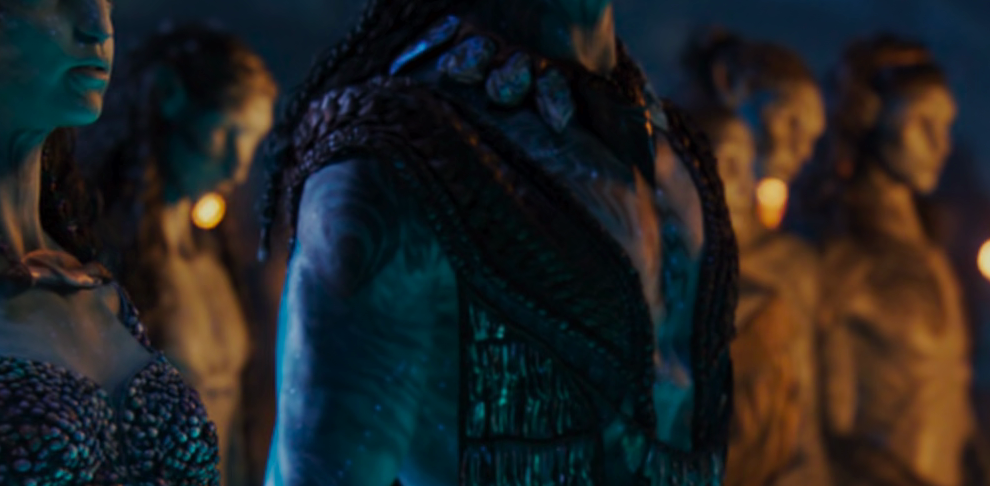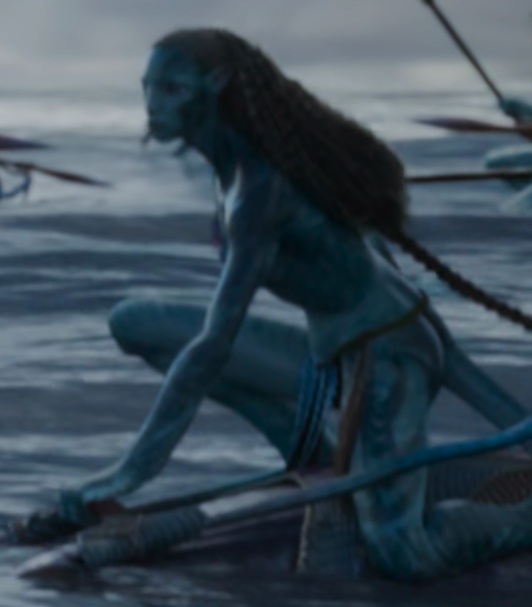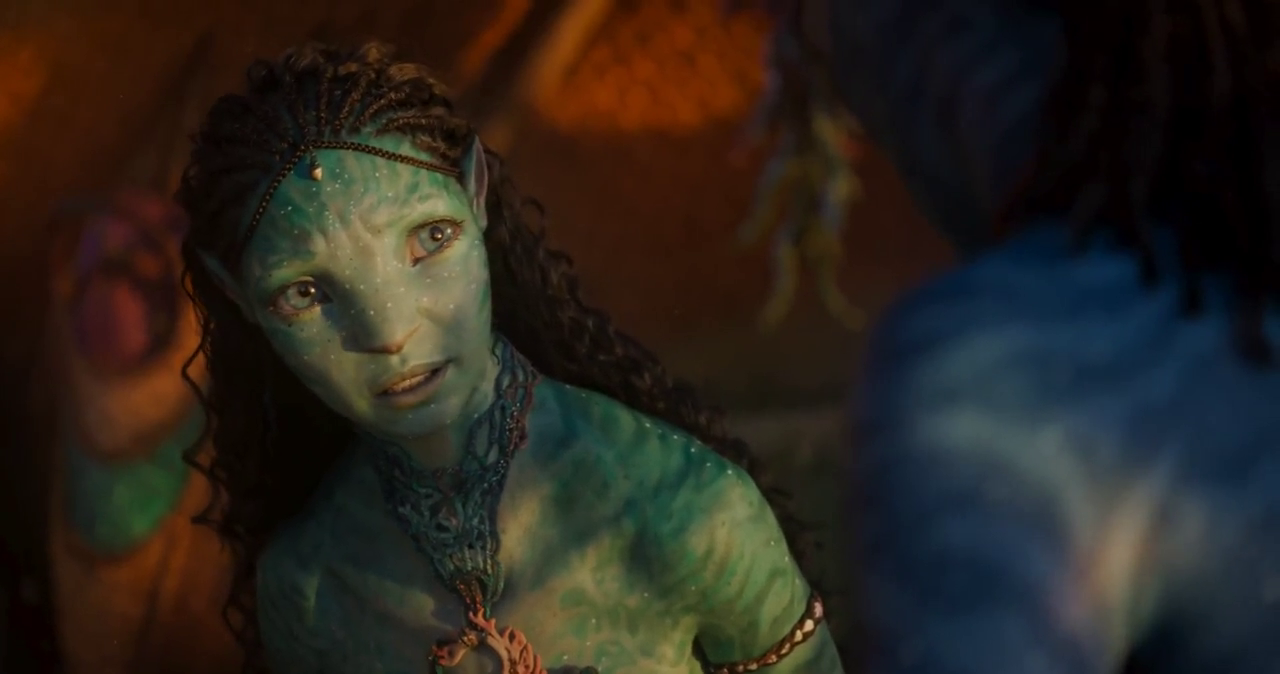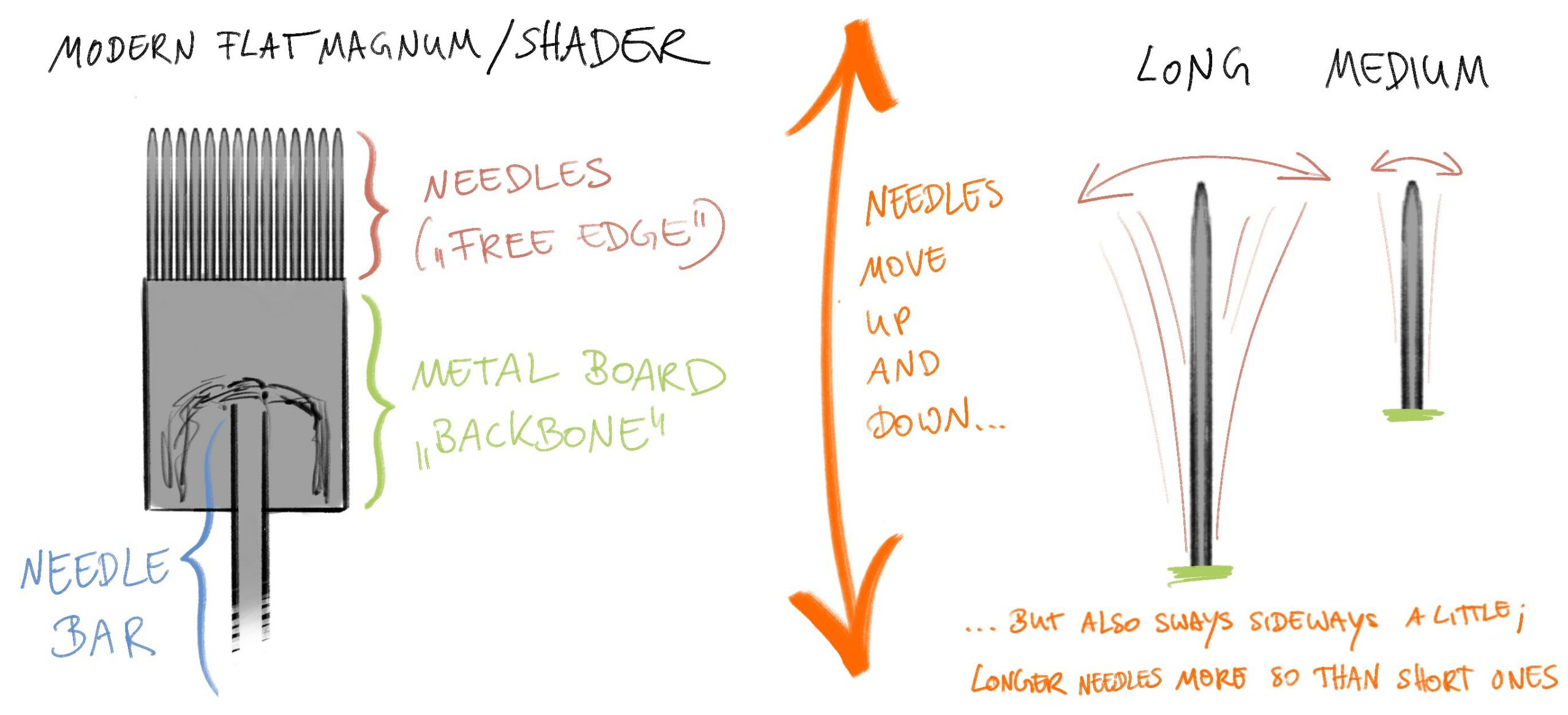Update (October 19th 2022)!
Preview images from one of the upcoming books for Avatar 2 were released via Amazon today – and in one of those preview images (the one about Tonowari) it has been confirmed that tattoos serve as an addition to display status / rank / role within the clan as well as live achievements on top of waytelem for the Metkayina:
Symbolic tattoos showcasing life events.
Metkayina Tattoos
Metkayina have striking tattoos, which are unique to each individual and chronicle their life. Each tattoo’s location on the body carries a special meaning. Tattoos over the heart and chest symbolize the safe embrace of the central island. Arm tattoos represent the more exposed protective shield of the seawall. Thus, a hunter of the deep ocean has densely tattooed arms and less detail on their chest.
The tattoos are considered a gift from both Eywa and the clan, and are created with inks from special animals.
Tonowari, as Olo’eyktan, has some of the most detailed and intricate tattoos of all the male Metkayina clan members. They range all over his face, torso, arms and back.Iknimaya
Much like Omatikaya teenagers, adolescent Metkayina must complete a number of coming-of-age rituals, known as Iknimaya, before they are considered to be adult members of the clan. One of these ceremonies includes bonding with a tsurak (skimwing) and various tests with their tulkun spirit brother or sister.
Once a Metkayina has completed these tests, they are bestowed with a special garment (left), their first tattoo, and three beads for their songcord.
This is so exciting ahhh~~
Still kinda needless to say, but still… :
!!! SPOILERS AND THEORIES AHEAD !!!
After I’ve dissected the trailer itself here: Avatar 2: The Way of Water – Teaser Trailer Synopsis … I want to dive into one particular aspect of it that caught my interest the most and wouldn’t let go of it:
Tattoos!
With the teaser trailer for Avatar 2: The Way Of Water being released, as a tattooist I was overjoyed to see that the Metkayina clan obviously practices the art of tattooing.
Here I want to dive a little into what we can see and infer from it. If you’re into tattoos, come along with me, because I will be rambling about the art and trade I love so much a lot ! :D
On what tattoos mean(t) to humans and what it could mean for Na’vi as well
The art of tattooing in general is probably as old as human existence itself. From the earliest times humans and art were tied together, and that did likely include practicing art on the human form itself. It can communicate and mean a lot, for example, being a member of a particular social group, having lived through / survived several events in life, a display of strength and maturity, or even medicinal practices:
Ötzi, that mummy found a while ago in the European Alps and born approx. 3275 BC, had 61 tattoos, mostly composed of simple lines. Examinations of his body made clear that he was an older male who was already suffering “age-conditioned or strain-induced degeneration”. The tattoos he had were close to or even on top of those areas that not unlikely caused him some health problems or even pain in his daily life, which could mean that those tattoos had not only a decorative, but also a medical background and meaning, as if to relieve any problems or pain. I’d even go so far and speculate that maybe the tattoos were even done during some sort of healing ceremony.
While tattoos are a popular phenomenon nowadays, it’s actually an ancient craft and has been common practice in Europe as well when Europeans started to sail the seas.
There’s still many indigenous people around who still (or fortunaltely again) practice traditional tattooing: The Māori, the indigenous people of New Zealand, practice Tā Moko, the Pe’a is the traditional tattoo on Samoa, Kurds have their Deq, the people from the Marquesas islands have their own style as well, and tattoos are also common on Borneo, among the Ainu and Inuit – just to name a few examples. I am by no means an expert on traditional tattoos like that, since I don’t specialize in it, but I still find it highly interesting and want to share what I do know thanks to my trade, but more on that later.
Well, long story short, I’d guess that for the Na’vi tattoos could mean similar things like they do for us humans. Social hierarchy and belonging, display of status, strength or maturity, a way to “record” life events and accomplishments, medicinal practices and remedies, as well as shamanistic rituals and as a means for spiritual connection to the world around them. For the Na’vi, it could also be a replacement for waytelem (see below). What they indeed do mean, we will probably and also hopefully learn when Avatar 2 hits the movie theaters. I do think, however, that Na’vi sporting tattoos fits well with the idea what they themselves are supposed to stand for and symbolize (no worries, I haven’t forgotten that the Na’vi are a fictional people inside a fictional universe, hrh).
Na’vi tattoos and patterns
I’ve been speculating since 2013 about whether or not the Na’vi would practice the art of tattooing as well (if you want to read my forum post from back then, you can find it here).
In the trailer for the new Avatar movie this question has been answered: The Na’vi do practice the art of tattooing. (Yay!!!)
We get a short but good look at some tattoos a couple of Metkayina wear:
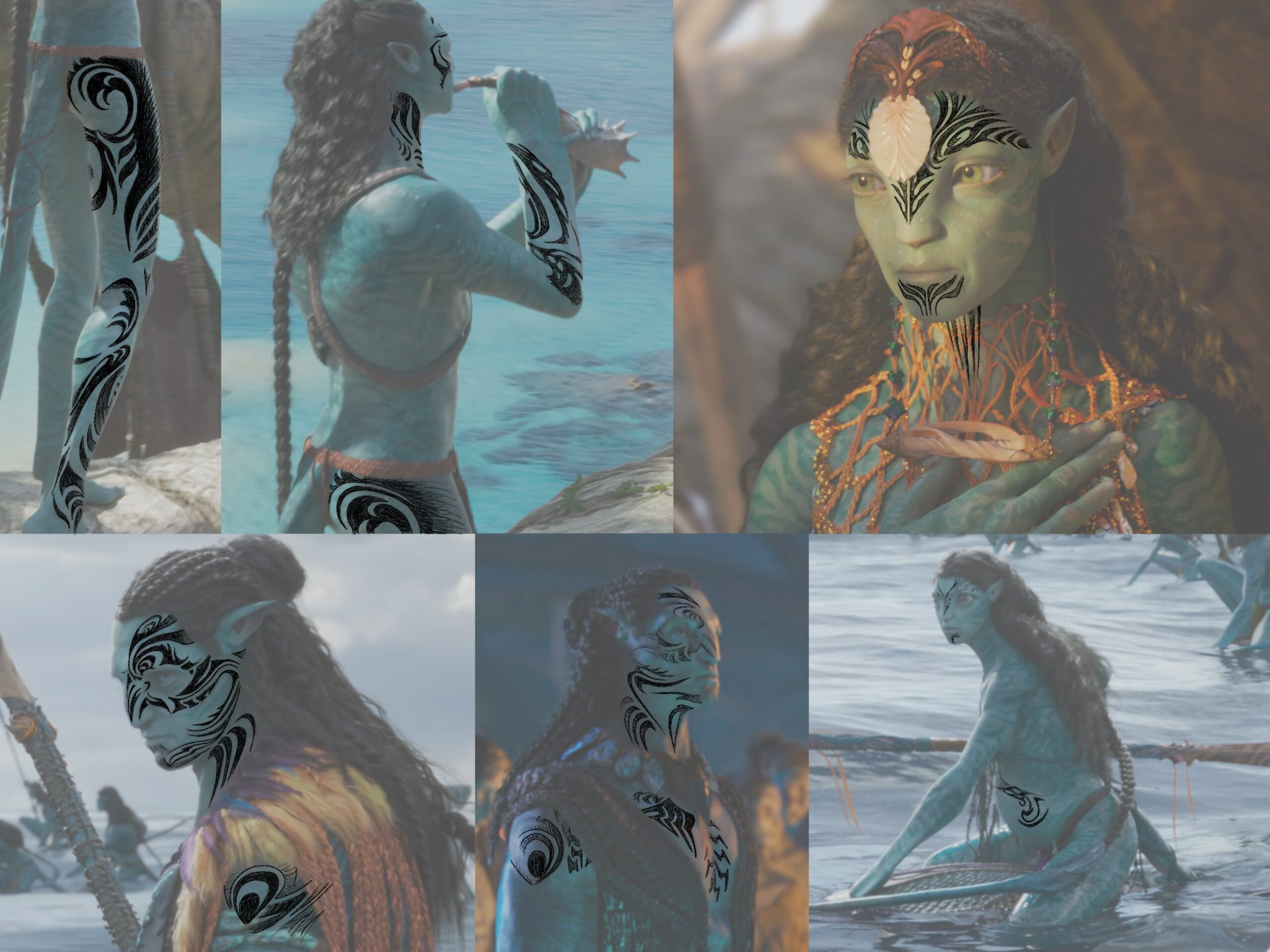
Description + possible meanings / symbolism
A random / unknown member of the Metkayina, standing on a tree root or trunk and blowing a horn. He wears big, bold and elaborate tattoos on his face, neck, forearm and leg.
His tattoos are overall very flowing and curvy, complimenting the individual body structures and shapes they’re decorating. The bigger pattern on the front of his thigh seems to fade out, the more it reaches the middle of the front.
The tattoos on the neck maybe resemble gills or whatever. The one on his forearm reminds me of a seashell, or in general organic structures that could appear all over Pandora, in plants, bones… it could also be a knife or something like that.
Tonowari, the Olo’eyktan of the Metkayina, wears intricate and bold angular as well as curvy patterns on his forehead, cheeks, chin, neck, chest and upper arm / deltoid.
Since he is the leader of the clan, it doesn’t surprise me that his tattoos so far appear to be the boldest. Very “aggressive” angular shapes as well as softer, rounded ones.
The tattoo on his forehead could resemble the head (plating) of a nalutsa or some other badass sea creature, something fierce that strikes fear in the hearts of his enemies. The tattoos on his neck remind me of gills as well, I could be reading too much into that, tho. But who knows. The circular shapes on his deltoid could be anything – from a swotu (sacred place, indicated by “stone archs”?) to the “Eye of Eywa” or just any eye, really. Could be something entirely different, too.
Ronal, the Tsahìk of the Metkayina, has elaborate, intricate, close-knitted patterns on her forehead, chin, neck and obviously pregnant belly.
The tattoo on her forehead is very intricate, and with the spirit and mind sitting primarily in the brain, I would assume this tattoo reflects her role as a Tsahìk, the spiritual leader of a clan, whose responsibility is to lead and give advice in all spiritual matters, including interpreting the will of Eywa, holding ceremonies and prayers and so on.
This tattoo could emphasize this responsibility and ability towards the spiritual side of Na’vi life, while the pattern pe se reminds me of swirling energy, but also spiney structures, maybe such as fish bones, which would resonate with the clan dwelling at / in the sea / reef, surrounded by maritime wildlife at all times.
The tattoo on her chin and neck are maybe connected to her voice and mouth, which could maybe mean that she is the one supposed to communicate and translate verbally the will of Eywa to the Na’vi via ayaungia (signs). This is highly speculative, of course.
The tattoo on her belly could be connected to her being pregnant, but I doubt that she got it after it became known that she is expecting. Tattooing pregnant individuals is not a good idea with humans, and I doubt it would be different with Na’vi… but who knows. Chances are high that this tattoo is not connected to her pregnancy at all, but rather to her status within the clan or the things that happened in her life (see below).
A documentation of life accomplishments / status within the clan?
I might want to go so far as to assume that the Metkayina sort of “earn” their tattoos. Whether through ceremonies or victories and stuff like that, something would have to happen in order for them to be worthy of their next tattoo. Let’s assume that this is the case and let’s compare stills with tattooed individuals in them, so we can see differences in the amount of tattoos every individual is wearing:
A pair of male Metkayina warriors or hunters (could be Rotxo to the left, and Aonung [Tonowari’s son, which means he could also be Ronal’s son and Tsireya’s brother] to the right). They are not teenagers anymore and probably already accomplished a thing or two in their lives, maybe having earned the tattoos they wear. Both wear tattoos on the face and chest.
Three of the four Metkayina in the background behind Tonowari and Ronal seem to wear face tattoos as well. One of them wears a chest piece, too.
This female warrior or hunter seems to have seen some shit, or just achieved quite a bit. I think I see tattoos on her leg, arm, as well as her cheek and forehead, apparently a lot more tattoos than the other warriors / hunters we just saw in the other stills.
Let’s compare those guys, including and especially the Tsahìk, to Tsireya, who I assume is to become the next Tsahìk of the Metkayina and who wears no tattoos at all (yet):
Tattooing children or teenagers is … eh, a very difficult topic with humans, and assuming the Na’vi “earn” their tattoos, it would make double sense that Tsireya is not yet wearing any. She’s maybe too young still to have achieved something worthy of a tattoo, or hasn’t gone through enough ceremonies yet to prove herself, like the one the Omatikaya practice (“dreamhunt” / uniltaron). Experience, growth and achievements come with age, so this would make perfect sense to me – and it would also explain why Tonowari has the most badass tattoos of them all, hrh. Because, you know, he’s the fricking leader of an entire clan, and he doesn’t look like life’s been very peachy for him.
Replacement for waytelem (song cord)?
If we continue this thought or theory, it would also kind of mean that the tattoos are a possible replacement for waytelem. I haven’t seen one single Metkayina wearing one of these so far, have you?
If you ask yourself what a waytelem (song cord) is, here’s a quick reminder:
“The Na’vi use mnemonic storytelling aids called Song Cords, strings of colored beads and bits of stone, bone and plant pieces which, when handled during singing, create a correlation of tactile and visual cues with verbal sequences. Each individual creates a Song Cord that is their personal history, and community Song Cords are created for various social purposes, including family and clan history, genealogy, and even the recording of astronomical and accounting information.” Source: Pandorapedia.com
So, a waytelem is something very near and dear to every Na’vi’s heart and identity – but the sea is rough and unforgiving, weathering and gnawing away at your waytelem, and the day you lose your waytelem in the vastness of the waves of saltwater would be a very, very bad day. Replacing a waytelem with a tattoo might’ve had a very practical reason at first (you can’t lose a tattoo), becoming cultural identity over time.
If waytelem indeed are replaced with tattoos, it would explain why the tattoos look so different in style and pattern on each individual Na’vi, and why some Metkayina wear more tattoos than others. Maybe there’s a visual language symbolism hidden within the tattoos only the Metkayina or Na’vi in general can understand, much like it’s the case with, for example, the Marquesan tattoo craft on Earth – or even only the one who did the tattoo and the one who wears it can “read” it.
Waytelem are also used, however, to record “family and clan history, genealogy, and even astronomical and accounting information”. If the Metkayina really use tattoos for this, I’d think they would reach limits there, not unless one or more tiretu (“shaman”) or anyone records these events and information on their body via tattooing. It’s also possible, though, that only the individual “waytelem” are tattooed, and the other, more general information is recorded in the more common way through song cords, weaving and other crafts and practices.
I think it’s a nice thought, life experiences and achievements “appearing” on your skin, don’t you think?
Individual tattoos for each individual character (trait)?
Instead of a means to record (personal) history and the like, here’s another theory as to why the tattoos look so different on each Metkayina we’ve seen so far:
In Japan, traditionally and as far as I know, there’s a practice of counterbalancing unwanted (or rather “negative”) personality traits or characteristics. For example, if someone is quick-tempered and easily erupts in anger, the tattooist would pick a tattoo design for that person to counterbalance this aspect of their personality, as if to soothe this side and achieve balance in character and demeanor. If someone was timid and shy, for example a fierce tiger tattoo would counterbalance this, and so on.
To me it is not impossible that a Na’vi tattooist would do the same, seeking to achieve balance and harmony within each individual who gets tattooed. But I think the life-achievement and waytelem theories are more probable, but maybe this balancing is a thought a Na’vi tattooist would take into consideration before deciding on the design.
Tattooist – a trade / profession in its own right?
I certainly do think, however, that the craft of tattooing, including picking the design, is entirely up to the one doing it. Could be that every tattoo is done during a spiritual ceremony. Could be that a shaman or even tsahìk are involved in picking the design, depending on the reason this tattoo is about to get added to each individual body. I doubt very much that a Na’vi would go to the clan’s tattooist and say “Yo, dude, I want some badass tattoo on my left butt cheek, like an akula, or… no, wait, I want a nalutsa!”, hrhn xD
But yeah, there’s got to be some artist who is responsible for this craft. I’m pretty sure that this is a social role / occupation in its own right, which would mean that there are indeed tattooists among the Na’vi. Which would also mean that there’s very likely going to be a word for “tattooist”, “tattoo”, and “tattooing” (finallyyyy!!!).
It is not unlikely that Na’vi tattooists are traveling between clans that have the art of tattooing as a part of their cultural identity, offering their trade and skill. It is also likely that tattooists are only tattooed on body areas they can reach / tattoo themselves, if they wear tattoos at all.
It is not impossible that any old tiretu or tseotu or the like could pick up a needle and some soot and tattoo something on somebody, but I really doubt that. Here’s why:
The tattoos shown on the Metkayina within the trailer are too elaborate to just be a job done by just anyone. It has to be its own profession, because there’s a lot to the craft that needs skill and experience. And let me tell you: doing symmetric / mirrored tattoos is especially difficult!
Possible tattooing techniques and tools
When we take a real close and good look at the face tattoos of the Tsahìk, it become clearer which approach and technique was probably used to do these:
The outline of every tattooed area is more apparent, stronger pigmented. As a tattooist, this tells me that these lines were probably done first, to get the overall shapes “cemented” into the skin, before moving on to filling the shapes. The design itself could have been either done without any pre-drawn stencil / drawing on the skin, or with something like that. Both could’ve been achieved by the Na’vi, because they are known to be amazing artists and craftsmen.
The outlined shapes then were filled with more lines and softer, more translucent shading. My educated guess is that these tattoos were done with a single needle, or very few and thin needles next to each other. If this is the case, it would’ve taken a lot of time and pain to get these tattoos done (that’s why on Earth even traditional tattooing is often done with modern machines nowadays). The Metkayina must’ve been living near or in the sea long enough, so that they even started to evolutionary diverge from their cousins from the forest. Such a process takes a long time, and I’d imagine that the Metkayina also had plenty of time to improve, if not perfect the art of tattooing.
Because of this, they, over time, likely developed more efficient and effective tools and methods to get the job done faster and neater. Not unlikely is the method of using a mallet to tap the skin with a needle-headed stick / tool. Like on Earth, they could apply the pigment on the skin itself beforehand, basically maybe even drawing the design on to the skin this way, before tapping the pigment into the skin. But dipping the needle in ink is just as likely and practicable.
In case needles were used at all, that is. Because there isn’t just one approach to get pigment into the skin. Humans used several methods here, from poking the skin with needles that were dipped in pigment beforehand, to tapping pigment-stained skin with just described mallets and needle-headed tools, to cutting the skin open and rubbing pigment into the wounds, to “sewing” the tattoos in between the layers of skin, by either twisting thread soaked with pigment around a needle and pushing it in and out of the skin, or attaching a pigment-soaked thread like you would for sewing cloth by hand.
The way these tattoos look, though, I do indeed think they used the “poking”, or rather “tapping” method, no sewing or cutting involved, even though we know that Na’vi skin, compared to human skin, is thicker, sturdier and likely less easy to penetrate. Cutting would’ve left visible scars, canyoned, scarred skin, if you will, but the tattooed areas still look smooth, so not (visibly) scarred. And sewing wouldn’t allow for such finely detailed and intricate work. So, needles it is.
Needles
For needles, a lot of materials are feasible. Bone, resin, stone, thorns, wood, sea shells, animal teeth or horn, basically anything that’s able to be worked / carved to become thin and sturdy enough to penetrate the skin and is not made of metal (because the Na’vi don’t use metal). Tattooists have been building workable tattoo needles from scratch for centuries, and in general it’s more feasible and efficient to carve out a magnum-style needle than to glue several individual needles together, as many old and traditional tattooing instruments from Earth have shown.
There’s some things about tattooing needles most of you likely don’t know, so let me explain. Modern tattooing needles have a certain scructure or rather are built a certain way for good reasons:
The needle bar connects the needle to the machine / its engine, transmitting movement, so the needle can move up and down with very high speed. The bar itself is soldered to a metal board / plate, which is the basis for the needles to be soldered on to, in modern needles they’re usually soldered on to the opposite site of the needle bar. The wider this board is, the more needles you can attach, in one or two rows, even. The less needles you need / want, the smaller / narrower the board gets. Lining needles most times aren’t soldered to a board at all, but directly on to the needle bar.
Efficient tattooing needles, no matter if for shading or lining, are composed of at least three needles. Smaller sizes / amounts do exist, but they don’t work as well, because less stability and ink flow, because ink, much like with a fountain pen, nestles between the needles (capillary action) and then gets transported into the skin this way by the needles. If there’s just one needle (a thorn, for example), there is no real capillary action, and tattooing is way less efficient. But the Metkayina in part have very large and elaborate tattoos, and they as well had a lot of time to hone this craft, so efficiency is what you’d want and get.
Also, inside the book “The World Of AVATAR: A Visual Exploration”, it is said that: “The Omatikaya believe that if a job is done correctly it should never be done again. With this in mind, the clan will take as long as it takes to perfectly construct a single bow, ax, or spear.” I wouldn’t be surprised if this applies to other clans, including the Metkayina, as well.
The crucial part is, however, the needle length. If you want more “oomph”, stronger penetration, bolder / crisper lines, better / more efficient results, shorter and a bit thicker needles are usually the way to go. Longer needles, due to the impact and movement of the needle itself, tend to bend and “sway” a little, so linework would get a bit blurred, less crisp, which is great for soft gradients, though. Since the Na’vi have thicker skin compared to us, you’d definitely need something with a little more “oomph”, so I am certain the Na’vi would use “short”, sturdy needles. Also due to efficiency reasons, there would most certainly be more than one needle at a time.
But just gluing loose needles or thorns together won’t provide enough support or “backbone” for the needles for efficient workflow, in my opinion. For a sturdy backbone to handle the impact forces and making sure the needles penetrate the skin easily, you need something made out of one piece at best, which is why we use metal nowadays and solder it together, so nothing will budge while working with it.
This is why tattooing needles very likely would look a lot like needles carved out of one piece, like many indigenous people use(d) and made them, maybe something like this:
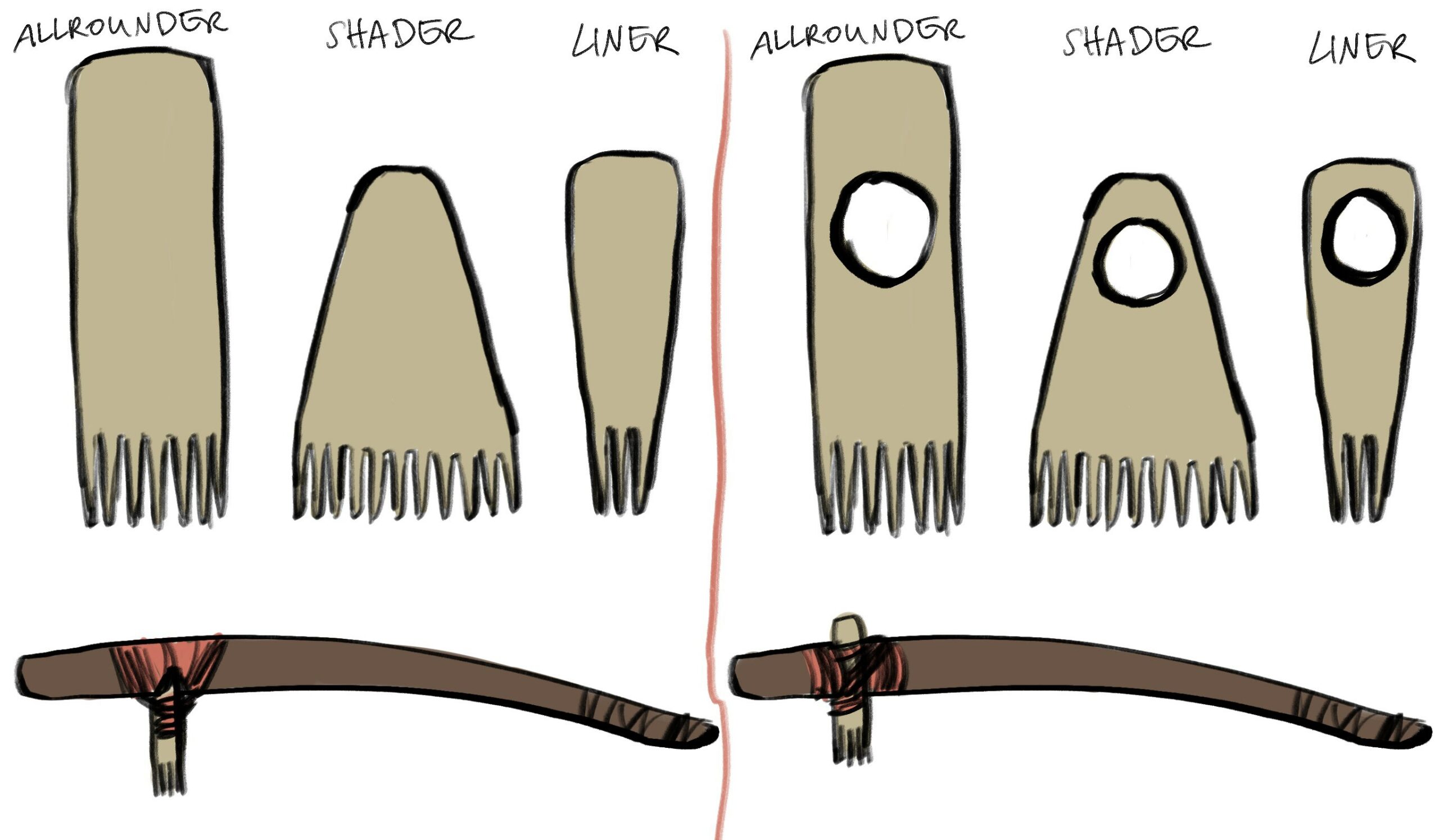
Pigments
As for pigments or rather tattoo inks, possible sources are herbal or insect-derived pigments or soot, mixed with oil, alcohol, urine, resin or plant extracts. Maybe it’s ink from a marine animal, or whatever material that is tolerated by Na’vi bodies and their immune systems, and doesn’t cause inflammation or allergic reactions, provides big enough particles that don’t get broken down easily by the immune system or UV-radiation. Also, big bonus, if the material has been cooked or burned long enough so it’s basically sterile (at first).
Soot, in my opinion, is the most likely choice of material, it hits all the checkmarks. We see the Metkayina using fire, so soot is readily available and sterile, high-pigmented and a strong black color, and it would provide UV-resistant pigment particles that are big enough, so that the body / immune system can’t break them down as easily over time (pigment is a foreign body and macrophages etc. try to break it down so the lymphatic system can transport it out of the system / organism – if the pigment particles are big enough and don’t get broken down easily by UV-radiation, the organism will actually not succeed in that and the tattoo will not fade / disappear, but instead macrophages hold the foreign bodies / pigment particles where they were placed and the tattoo gets fixated where it was deposited). Soot has proved to work well in that regard, and has been used for that same reason on Earth as a tattoo pigment since the beginnings of this craft (not anymore, of course, because we have healthier / less dangerous pigments nowadays).
Here’s my take on what possible tools and the tattooing process might look like:
Inspiration / influence during the process of creating the Metkayina
Of course it’s entirely possible that I am overthinking this way too much and probably more than the team of concept artists behind creating the Metkayina and their tattoos. It’s possible they just went “Yo, tattoos! Would look awesome” and just randomly added patterns to some of the Metkayina, without giving it much thought whatsoever. But I think that’s unlikely, simply because:
Weta Digital, massively involved in creating Avatar 1 and the sequels, is located in New Zealand. Many actors trained in the forests of New Zealand for Avatar 1. Cliff Curtis, who portrays Tonowari, is born in New Zealand and is of Māori descent. New Zealand is the home of the Māori, and they have been and are still practicing their own style and ways of tattooing. For this style of tattooing, Tā Moko, similar tools and techniques have been used. The tattoo patterns of the Metkayina resemble those of the Māori the most, compared to all other examples I’ve given at the beginning of this very long post. The hair bun on Tonowari’s head resembles those of Māori culture, as well as the waist garments the Metkayina seem to be wearing. Need I say more? Come on, I am clearly not overthinking this. ;P
Other types of bodymodifications
The Na’vi sport piercings, be it inside ears, noses or other body parts, and they also wear tattoos. There’s more ways of embellishing your body, though. Scarification is a thing, cuttings, implants, brandings, amputations and much more. I’d love to see even more bodymodifications in the coming sequels. But even if piercings and tattoos is all we’re gonna get, I’m very happy with just these types of body piercings and tattoos, don’t get me wrong xD
